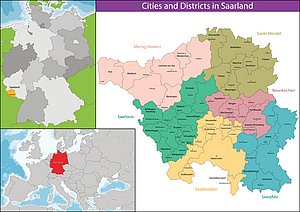Welcome in the heart of Europe
Welcome to Saarland, in the heart of Europe! A high quality of life, friendly and open people, and affordable living costs make Saarland a very livable region with an international flair. To the north and east, Saarland shares a border with the German federal state of Rheinland-Pfalz, to the south with the French region Grand Est with its Département Moselle, and to the west with the Grand Duchy of Luxembourg. Saarland, with these neighbors and the Belgian region of Wallonia, together make up the European Greater Region of Saar-Lor-Lux. Altogether about 11.6 million people live here.
Saarland is a region that can offer a good life. Leisure activities and places of interest for tourists, its exciting location at a juncture between France, Luxembourg, and the rest of Germany, an appealing landscape, as well as an affordable cost of living -- these all speak in favor of Saarland.
Saarland has a top-performing and multi-faceted university and research landscape, and it is successful in many technological fields both nationally and internationally. Made-in-Saarland IT, healthcare and medical technology, research in pharmaceuticals and active substances, nano- and biotechnology, but also materials sciences, mechatronics as well as automotive and automotive supplier technology all enjoy an excellent reputation worldwide. Besides the headquarters for the German Research Center for Artificial Intelligence (DFKI) and the CISPA – Helmholtz Center for Information Security, all other German research organizations such as several Max Planck and Fraunhofer Institutes are represented here. With unequalled geographic density of research excellence, Saarland plays in the upper ranks of the global Champions League when it comes to innovation for the future.
Saarland offers a vibrant university landscape. With its six institutions of higher education, prospective students have a wide diversity of options to choose from. The region’s special expertise in matters French and European is a compelling asset. This is especially evident in its close cooperation with cross-border institutions in higher education and research.



